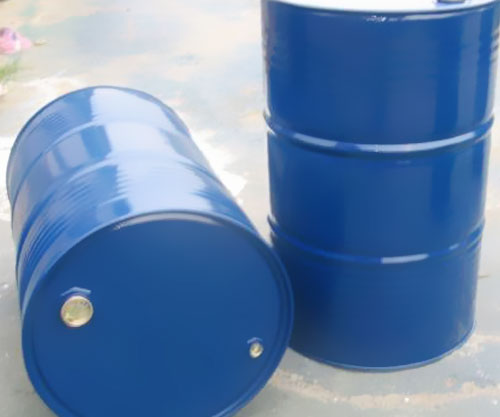
Shandong dichloroethane manufacturer analyzes the characteristics of dichloroethane for you
- Categories:Company News
- Author:
- Origin:
- Time of issue:2020-06-16
- Views:0
(Summary description)2. Used for boron analysis, oil and tobacco extractant. Also used in the manufacture of acetyl cellulose.
3. Used as analytical reagent, such as solvent, chromatographic analysis standard substance. It is also used for the extraction of oils and fats, and for organic synthesis.
4. Used as detergent, extractant, pesticide and metal degreasing agent, etc.
5. Used as a solvent for wax, fat, rubber, etc. and cereal insecticide.
Dangerous characteristics of dichloroethane: its vapor forms an explosive mixture with air, and it will cause combustion and explosion in case of open flame and high heat energy. It can react with oxidants. Decomposition by high heat produces toxic corrosive gas. Its vapor is heavier than air, and can spread to a relatively far place in the lower place, and it will be re-ignited when it meets the fire source. In case of high heat, the internal pressure of the container increases and there is a risk of cracking and explosion. Corrosion of plastics and rubber. Flammability (red): 3 Reactivity (yellow): 0
Combustion (decomposition) products: carbon monoxide, carbon dioxide, hydrogen chloride, phosgene.
Stability: stable
Taboos: strong oxidants, acids, alkalis.
Polymerization hazard: cannot appear
Fire extinguishing methods: foam, dry powder, carbon dioxide, sand, mist water. If the substance or contaminated fluid enters the waterway, notify downstream users of potential water pollution, and notify local health and fire officials and pollution control departments.
Leakage disposal
Evacuate the personnel from the contaminated area to the safe area, prohibit unauthorized personnel from entering the contaminated area, and cut off the fire source. It is recommended that emergency personnel should wear protective equipment. Stop leaks while ensuring safety. Water spray mist will reduce evaporation, but cannot reduce the flammability of the leakage in the restricted space. Absorb with sand, vermiculite or other inert materials, then collect and transport to waste disposal site for disposal. It can also be scrubbed with an emulsion made of non-combustible dispersant, and the diluted wash water is put into the wastewater system for treatment and discharged after reaching the standard. If there is a large amount of leakage, use the dike for containment, and then collect, transfer, and recycle the contaminated site for harmless treatment.
Shandong dichloroethane manufacturer analyzes the characteristics of dichloroethane for you
(Summary description)2. Used for boron analysis, oil and tobacco extractant. Also used in the manufacture of acetyl cellulose.
3. Used as analytical reagent, such as solvent, chromatographic analysis standard substance. It is also used for the extraction of oils and fats, and for organic synthesis.
4. Used as detergent, extractant, pesticide and metal degreasing agent, etc.
5. Used as a solvent for wax, fat, rubber, etc. and cereal insecticide.
Dangerous characteristics of dichloroethane: its vapor forms an explosive mixture with air, and it will cause combustion and explosion in case of open flame and high heat energy. It can react with oxidants. Decomposition by high heat produces toxic corrosive gas. Its vapor is heavier than air, and can spread to a relatively far place in the lower place, and it will be re-ignited when it meets the fire source. In case of high heat, the internal pressure of the container increases and there is a risk of cracking and explosion. Corrosion of plastics and rubber. Flammability (red): 3 Reactivity (yellow): 0
Combustion (decomposition) products: carbon monoxide, carbon dioxide, hydrogen chloride, phosgene.
Stability: stable
Taboos: strong oxidants, acids, alkalis.
Polymerization hazard: cannot appear
Fire extinguishing methods: foam, dry powder, carbon dioxide, sand, mist water. If the substance or contaminated fluid enters the waterway, notify downstream users of potential water pollution, and notify local health and fire officials and pollution control departments.
Leakage disposal
Evacuate the personnel from the contaminated area to the safe area, prohibit unauthorized personnel from entering the contaminated area, and cut off the fire source. It is recommended that emergency personnel should wear protective equipment. Stop leaks while ensuring safety. Water spray mist will reduce evaporation, but cannot reduce the flammability of the leakage in the restricted space. Absorb with sand, vermiculite or other inert materials, then collect and transport to waste disposal site for disposal. It can also be scrubbed with an emulsion made of non-combustible dispersant, and the diluted wash water is put into the wastewater system for treatment and discharged after reaching the standard. If there is a large amount of leakage, use the dike for containment, and then collect, transfer, and recycle the contaminated site for harmless treatment.
- Categories:Company News
- Author:
- Origin:
- Time of issue:2020-06-16
- Views:0
1. Mainly used as raw materials for vinyl chloride; ethylene glycol; oxalic acid; ethylenediamine; tetraethyl lead; polyethylene polyamine and dibenzoyl. Also used as grease; resin; rubber solvent, dry cleaning agent, pesticide pyrethrin; caffeine; vitamin; hormone extractant, wetting agent, penetrating agent, petroleum dewaxing, anti-shock agent, also used in pesticide manufacturing and medicine Benzomide; raw material for piperazine. It can be used as grain in agriculture; fumigant for grain; soil disinfectant, etc.

2. Used for boron analysis, oil and tobacco extractant. Also used in the manufacture of acetyl cellulose.
3. Used as analytical reagent, such as solvent, chromatographic analysis standard substance. It is also used for the extraction of oils and fats, and for organic synthesis.
4. Used as detergent, extractant, pesticide and metal degreasing agent, etc.
5. Used as a solvent for wax, fat, rubber, etc. and cereal insecticide.
Dangerous characteristics of dichloroethane: its vapor forms an explosive mixture with air, and it will cause combustion and explosion in case of open flame and high heat energy. It can react with oxidants. Decomposition by high heat produces toxic corrosive gas. Its vapor is heavier than air, and can spread to a relatively far place in the lower place, and it will be re-ignited when it meets the fire source. In case of high heat, the internal pressure of the container increases and there is a risk of cracking and explosion. Corrosion of plastics and rubber. Flammability (red): 3 Reactivity (yellow): 0
Combustion (decomposition) products: carbon monoxide, carbon dioxide, hydrogen chloride, phosgene.
Stability: stable
Taboos: strong oxidants, acids, alkalis.
Polymerization hazard: cannot appear
Fire extinguishing methods: foam, dry powder, carbon dioxide, sand, mist water. If the substance or contaminated fluid enters the waterway, notify downstream users of potential water pollution, and notify local health and fire officials and pollution control departments.
Leakage disposal
Evacuate the personnel from the contaminated area to the safe area, prohibit unauthorized personnel from entering the contaminated area, and cut off the fire source. It is recommended that emergency personnel should wear protective equipment. Stop leaks while ensuring safety. Water spray mist will reduce evaporation, but cannot reduce the flammability of the leakage in the restricted space. Absorb with sand, vermiculite or other inert materials, then collect and transport to waste disposal site for disposal. It can also be scrubbed with an emulsion made of non-combustible dispersant, and the diluted wash water is put into the wastewater system for treatment and discharged after reaching the standard. If there is a large amount of leakage, use the dike for containment, and then collect, transfer, and recycle the contaminated site for harmless treatment.
Scan the QR code to read on your phone
Relevant information
News list:
- Shandong Xinjucheng International Trade Co., Ltd. 2020-06-20
- Chlorinated Polyethylene 2020-06-16
- Shandong dichloroethane manufacturer analyzes the characteristics of dichloroethane for you 2020-06-16
- Institutional research focuses on the chemical industry 2020-06-16
- Significant achievements in energy saving and emission reduction 2020-06-16
Shandong Xinjucheng International Trade Co.,Ltd.
Zhang:+86-18854377527
Han:+86-15666638333
Samantha Tel/whatsapp:008613793143830
Abby: Tel/whatsapp: 008618253146362
Susan: Tel/whatsapp:008618253123705
E-mail:2831202430@qq.com
Add:100 meters east of Zhujiacun Village Committee, Changshan Town, Zouping City, Shandong Province
Contact us by Wechat

Zhang

Han
